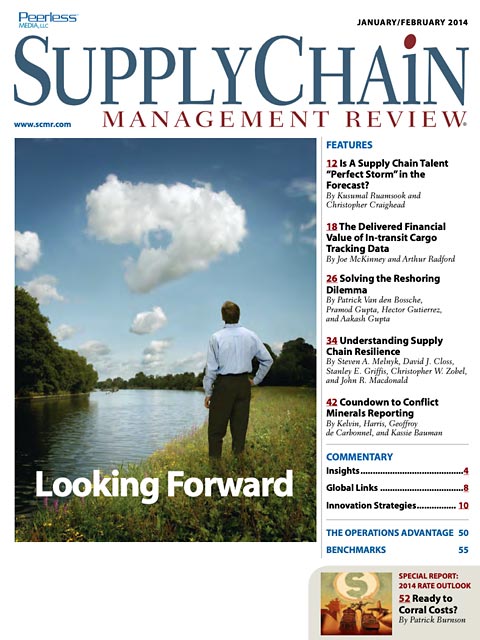Sorry, but your login has failed. Please recheck your login information and resubmit. If your subscription has expired, renew here.
January-February 2014
With the demands for more skilled supply chain professionals, the silver tsunami of retiring workers, and a shortage of supply chain students and instructors, a perfect storm may be brewing. Penn State authors Kusumal Ruamsook and Christopher Craighead outline the factors that may limit the pool of supply chain talent and offer five strategies to help weather the storm. Get this issue to learn more. Browse this issue archive.Need Help? Contact customer service 847-559-7581 More options
The clock is ticking—loudly. By May 31st this year, public companies have to comply with the U.S. Securities and Exchange Commission’s Conflict Minerals filing requirement. This is not a job for the legal department alone: It will require active input from operations leaders—notably from supply chain executives. Nor is the filing just a one-off requirement: It will call for ongoing effort far into the future.
The rule is one of several SEC rules mandated by the Dodd-Frank Act that are intended to provide transparency into corporate practices. In the case of this regulation—Section 1502 of the Act—the ultimate intent is to reduce funding for armed groups involved in human rights violations in the Democratic Republic of the Congo (DRC), Angola, Burundi, Central African Republic, the Republic of the Congo, Rwanda, South Sudan, Tanzania, Uganda, and Zambia (collectively, “the covered countries”).1,2
The four so-called “conflict minerals”—tantalum, tin, tungsten, and gold—are primary sources of funding for the armed groups. Also known as “3TG,” these materials are essential to the production of countless products. They are fundamental in electronics equipment of all types, to be sure, but they are also critical to the manufacture of everything from drill bits and golf clubs to jewelry, zippers, and buttons. They are even used in some types of PVC and glass.
 |
This complete article is available to subscribers
only. Click on Log In Now at the top of this article for full access. Or, Start your PLUS+ subscription for instant access. |
Not ready to subscribe, but need this article?
Buy the complete article now. Only $20.00. Instant PDF Download.
Access the complete issue of Supply Chain Management Review magazine featuring
this article including every word, chart and table exactly as it appeared in the magazine.
SC
MR
Sorry, but your login has failed. Please recheck your login information and resubmit. If your subscription has expired, renew here.
January-February 2014
With the demands for more skilled supply chain professionals, the silver tsunami of retiring workers, and a shortage of supply chain students and instructors, a perfect storm may be brewing. Penn State authors Kusumal… Browse this issue archive. Access your online digital edition. Download a PDF file of the January-February 2014 issue.
 |
Download Article PDF |
The clock is ticking—loudly. By May 31st this year, public companies have to comply with the U.S. Securities and Exchange Commission’s Conflict Minerals filing requirement. This is not a job for the legal department alone: It will require active input from operations leaders—notably from supply chain executives. Nor is the filing just a one-off requirement: It will call for ongoing effort far into the future.
The rule is one of several SEC rules mandated by the Dodd-Frank Act that are intended to provide transparency into corporate practices. In the case of this regulation—Section 1502 of the Act—the ultimate intent is to reduce funding for armed groups involved in human rights violations in the Democratic Republic of the Congo (DRC), Angola, Burundi, Central African Republic, the Republic of the Congo, Rwanda, South Sudan, Tanzania, Uganda, and Zambia (collectively, “the covered countries”).1,2
The four so-called “conflict minerals”—tantalum, tin, tungsten, and gold—are primary sources of funding for the armed groups. Also known as “3TG,” these materials are essential to the production of countless products. They are fundamental in electronics equipment of all types, to be sure, but they are also critical to the manufacture of everything from drill bits and golf clubs to jewelry, zippers, and buttons. They are even used in some types of PVC and glass.
 |
SUBSCRIBERS: Click here to download PDF of the full article. |
SC
MR

Latest Supply Chain News
- Technology’s role in mending supply chain fragility after recent disruptions
- Tech investments bring revenue increases, survey finds
- Survey reveals strategies for addressing supply chain, logistics labor shortages
- Israel, Ukraine aid package to increase pressure on aerospace and defense supply chains
- How CPG brands can deliver on supplier diversity promises
- More News
Latest Podcast

 Explore
Explore
Latest Supply Chain News
- Technology’s role in mending supply chain fragility after recent disruptions
- Tech investments bring revenue increases, survey finds
- Survey reveals strategies for addressing supply chain, logistics labor shortages
- Israel, Ukraine aid package to increase pressure on aerospace and defense supply chains
- How CPG brands can deliver on supplier diversity promises
- How S&OP provides the answer to in-demand products
- More latest news
Latest Resources

Subscribe

Supply Chain Management Review delivers the best industry content.

Editors’ Picks





